In this article, we review the SMSL SU-6 DAC & the SMSL SH-6 AMP. They respectively cost $169 USD and $119 USD.
Disclaimer: ShenzhenAudio sent us the SU-6 & the SH-6 for this review, free of charge. I only covered the customs fees & taxes. All thoughts and experiences with the product are naturally my own.
This review consists of 3 pages. The SMSL SU-6 will be reviewed on page 1, the SMSL SH-6 will be reviewed on page 2 and the joint performance of the two will be evaluated on page 3.
SMSL SU-6 Compact Desktop DAC
The SMSL SU-6’s dedicated web page can be found here. It costs $169 USD from Shenzhen Audio.
The SMSL SU-6 is a budget-friendly, high-performance DAC that can decode PCM up to 32bit-768kHz and DSD up to DSD512, natively, via USB. It is powered by the ESS Technology’s ES9038Q2M premium-tier DAC. Additionally, the DAC is accompanied by the time-tested OPA1612s. The DAC also comes with full LDAC support through Bluetooth 5.0 and that’s great. We don’t see LDAC at this price point, very often. Furthermore, the SU-6 features remote control support and a tempered glass screen. As a complete package, I think it will be quite competitive in the current DAC market.
Here are the highlights of the SMSL SU-6 Desktop DAC.
- ESS Technology ES9038Q2M DAC
- 2nd Generation XMOS USB Controller
- Low Noise Switching Power Supply
- Bluetooth 5.0 + LDAC 24bit/96kHz, APTX/HD, SBC, AAC
- x4 OPA1612 + Advanced Audio Circuit Design
- Remote Control Support
- USB-C / Optical / Coax / RCA – I/O
- 32bit-768kHz PCM & DSD512 Support
- DAC Drivers can be found here.
Packaging & Accessories
SMSL SU-6 comes in a small, white rectangular box. The box design is nice. The packaging is not as plain as other units from SMSL. The top side of the package has the device outline image and it looks quite well. Now you know what is inside without looking at the side sticker like before. Furthermore, SMSL is still after simplicity and there are no specifications or any product info listed anywhere on the box. Upon opening the box, you’re welcomed by the foam compartment that protects the device from damage during transportation.
As for the accessories, SMSL provides a USB-A to USB-C data cable, their newly redesigned remote, a couple of manuals, an antenna, and a C7 power cable. This is the first time I am seeing SMSL using the C7 power cable instead of the regular C13. I suppose they did this to reduce the occupied space of the heftier C13 power socket on the PCB. Together with that, I must let you know that the included power cable is a bit short. It is 1m long to be exact and that could be a challenge for some people.
Apart from that, SMSL’s new remote looks very nice with rounded corners and an improved black finish. It still works with 2x AA batteries and the buttons feel slightly easier to push.
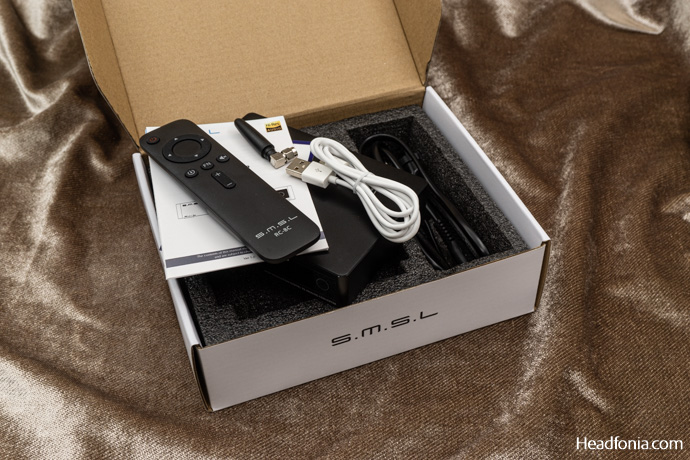
Design & Build Quality
Measuring 14 x 2.8 x 10.5 (WxHxD) centimeters, the SU-6 is TINY!
It is even smaller than the Topping D10B and it is just a little bigger than the Khadas Tone 2 Pro. The SU-6 has a similar build quality compared to other SMSL products with CNC machined aluminum chassis and partly glass front panel. Additionally, the SU-6 features a touch button instead of the SMSL’s usual volume knob/button combo. Not to worry though, the volume is easily adjustable through the included remote.
The SU-6 is available in both Silver and Black metallic finishes. The review unit I have is in black and it features the same quality level of paint and texture that we had seen on other, higher-priced SMSL units. The unit looks very chic and compact in person, it feels like a premium unit despite the budget price tag.
As for the layout, all the I/O options are located on the rear side of the SU-6. From left to right, there are the unbalanced RCA outputs, coaxial, optical, USB-C input, antenna socket, and the C7 power socket lying side by side on the back of the compact unit. The I/O options are quite rich for a compact unit and it seems that the SMSL did their best to squeeze in as many components as they can into the small chassis of the SU-6. The RCAs and the coaxial socket are gold-plated and feel rigid. I can’t see any imperfections anywhere on the chassis. It looks like a job well done, like usual from SMSL.
Let’s move on to the details of the front panel. We see a tempered glass screen with a bright white font. The brightness level is adjustable through the menus. The screen provides info about the sample rate during the playback and it can also show the volume level and active input, however, there is no UI to show them all in a single screen. The default screen is the sample rate and that’s it. At first, after seeing many Topping devices with orange fonts, the SMSL white felt weird. After a brief adjustment period, I started liking it a lot! I think it looks brilliantly simple, and, elegant.
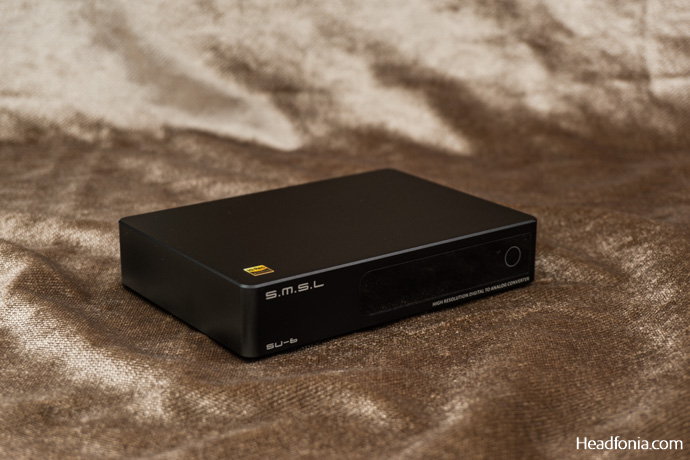
Controls & UI
Essentially, the SU-6 offers two methods of control. The integrated touch button and the included remote. Of course, the touch button does not offer comprehensive controls as the remote does however, it can be used to switch between inputs. You can also hold it for the unit to go into standby mode. On another note, the beautiful white font display has a weakness compared to bigger SMSL units. It cannot display multiple information. During the playback, the SU-6 only displays the sample rate of the track that is playing. This could be labeled as a negative, but I personally like the simplistic look of it. It looks quite chic in my dimly lit, black and white themed room.
As for the remote controller, it is very easy to learn how to use the menus. You can navigate through settings by pressing the center button once and then using the left and right buttons. There are three settings. You can switch between filters from 1 to 7, you can adjust the DPLL (digital phase-locked loop) and you can adjust the brightness level of the white font display. You can also quickly mute the device using the dedicated mute button on the remote. Apart from those, you can control the DAC’s volume using the dedicated volume buttons and you can also turn off the display by pressing the FN button. This button is especially useful when you are in a pitch dark room. If you want to take a look at the controls I mentioned above, you can do so, here.
Bluetooth Capability
The SU-6 has a Bluetooth 5.0 chip inside and it supports the LDAC codec. If you are following my review, I expected LDAC from SU-8s but sadly it was not supported. I am genuinely surprised to see this budget DAC featuring full 24-96 LDAC support. I’ll talk about the LDAC sound performance in the next chapter but I must say that I am quite happy to see LDAC in a DAC under the 200 mark. The SU-6 also supports APTX-HD, SBC, and AAC.
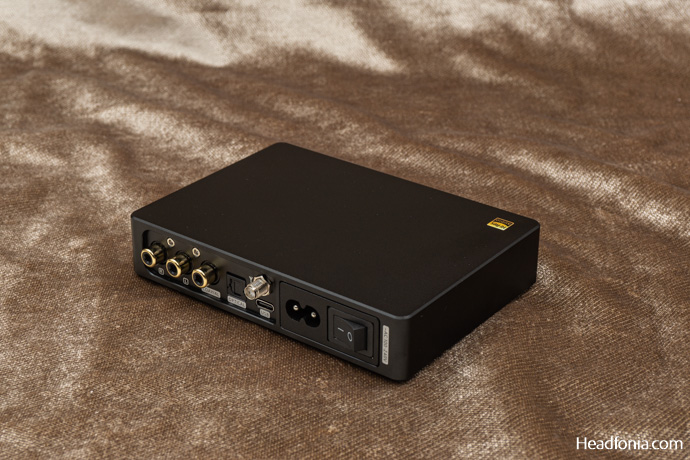
DAC Performance
In this section, I will describe the DAC’s signature and sound performance, without the SH-6 Amplifier. For this test, I am pairing the DAC directly with my active reference monitors. I will also pair it with several headphone amplifiers.
The SU-6 sounds flat, colorless, and linear to my ears. The timbre does not feel saturated, at all. I am acquainted with well-implemented ES9038Q2M DAC chips and what I am hearing is an absolutely great performance for the price. The resolution is very good. The PRaT feels great as well. The transients are fast and snappy. The DAC reflects the track as it is, without unwanted dips or peaks. It sounds balanced throughout the frequency spectrum. The DAC also scales well with other amps. I can easily pair it with the higher-priced SH-8s and I don’t feel a bottleneck. That’s great when you think about the price of the unit and what you get in return. I honestly can’t find where exactly SMSL cut corners, I mean, they have to, right? No? Well, you have LDAC, a solid DAC implementation with a great audio board featuring x4 premium-grade OP-Amps, an XMOS USB controller, a rich I/O selection, and a built-in PSU. These specs, these features are very impressive for this price range and I can understand why the SMSL has saved this device for 2022. After spending a few days with this combo, I can say that the SMSL has made a really quick start to 2022.
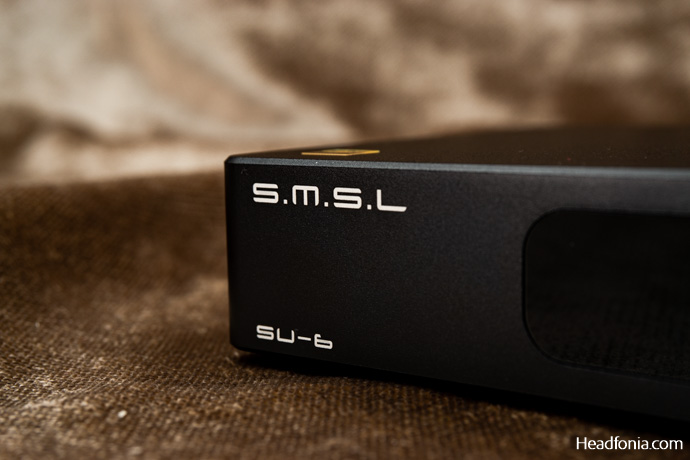
To recap, SU-6 offers a very good tonal balance, reflects the tracks as it is, without added coloration. Technical-wise, it is a solid DAC with great imaging, a very good PRaT, and resolution. It sounds clean, resolving, and transparent. Let’s compare it to the new DX3 Pro+. The new DX3 Pro+ is an exciting product. It is an AIO unit with an integrated DAC and an AMP inside a small chassis. I compared its DAC-mode with the SU-6 and found out that there are small differences between the two, really good units. First of all, I noticed that the DX3 Pro+ has sharper upper mids compared to the SU-6. It feels like the attack and the decay are a little more emphasized than the SU-6. Pairing it with bright-sounding gear could potentially lead to issues for the treble-sensitive audiophile. For example, Grado’s PS500e matches better with the SU-6, using the same amp for both of the devices. On another hand, pairing the DX3 Pro+ with the Sennheiser & Drop’s 58X gives a better result due to 58X’s recessive upper midrange.
Another point that really got me excited was the SU-6’s wireless DAC performance. I really had to pay attention to differentiate between the wired and the wireless sound quality with my reference monitors. I was quite surprised because of this and I had to replace it with my daily driver Bluetooth DAC, FiiO BTA30. I immediately slapped the SU-6 on the side of the bookshelf speaker with a couple of velcros and I was done. Proper wireless DACs? What a time to be alive!
Overall, I must say that I am quite impressed by the performance we get from a 169 USD DAC. It really is interesting to see these hand-sized devices catch up with 2019’s flagship DACs that cost many times more.
The review continues on Page Two, after the click HERE or by using the jump below.
Page 2:SMSL SH-6 Desktop Amp, Packaging & Accessories, Design & Build Quality, Power & Controls, AMP Performance
Page 3: SMSL SU-6 & SH-6 DAC & AMP Stack Performance, Comparisons, Pairings, Last Words






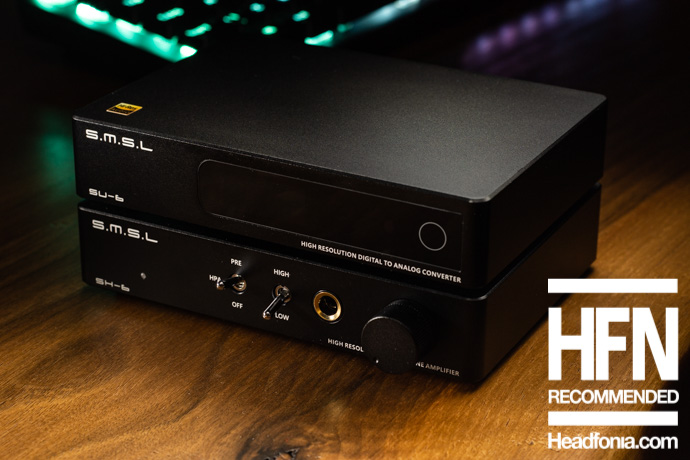
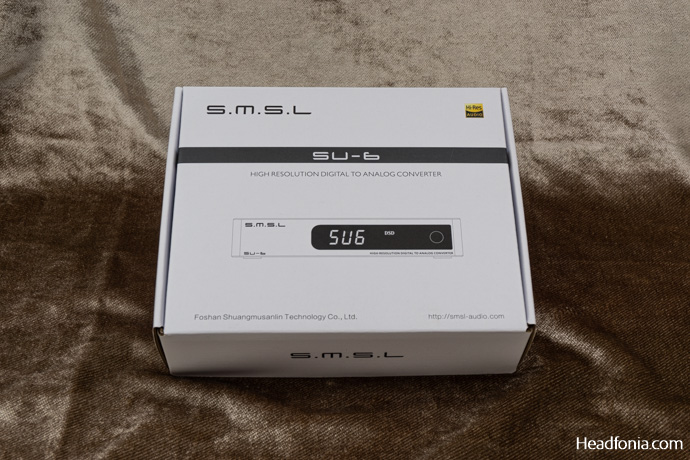


Steve From Tassie
going to page 2 404s.
Lieven
fixed!
Gregory Davis
This SMSL gear is otherworldly, your reviews are spot on.
Yagiz
Thanks Gregory, glad to hear that!
Viktor
Yagiz review more SMSL pls
Yagiz
Thanks man, stay tuned
Tofan Yatnakriana
I have Fostex TH900 and Senn HD600 and trying to find first dac+ amp combo for them. Previously I only use ifi hip dac to drive those two headphones and found I need more power to make them shine. So does this SMSL combo will be better option than my ifi hip dac?
Yagiz
Yes, I would think so, Tofan.
George
Can you connect this device to a set of wireless headphones and play music through them or is it only Bluetooth receiver? Sorry for the noob comment, please answer me cause I m a bit frustrated.
Yagiz
Unfortunately, no. You need a tranceiver, I recommend looking at the FiiO BTA 30 Pro for your needs.
J.O.B.G
I’ve got a S.M.SL SU-6, it works great connected to my iPad, but when I use it with the iMac I only get 44.1 (setup and configuration in the iMac is OK) it doesn’t matter if I’m playing DSD or a 192K Flac files, it always shows 44.1 quality. Any help?